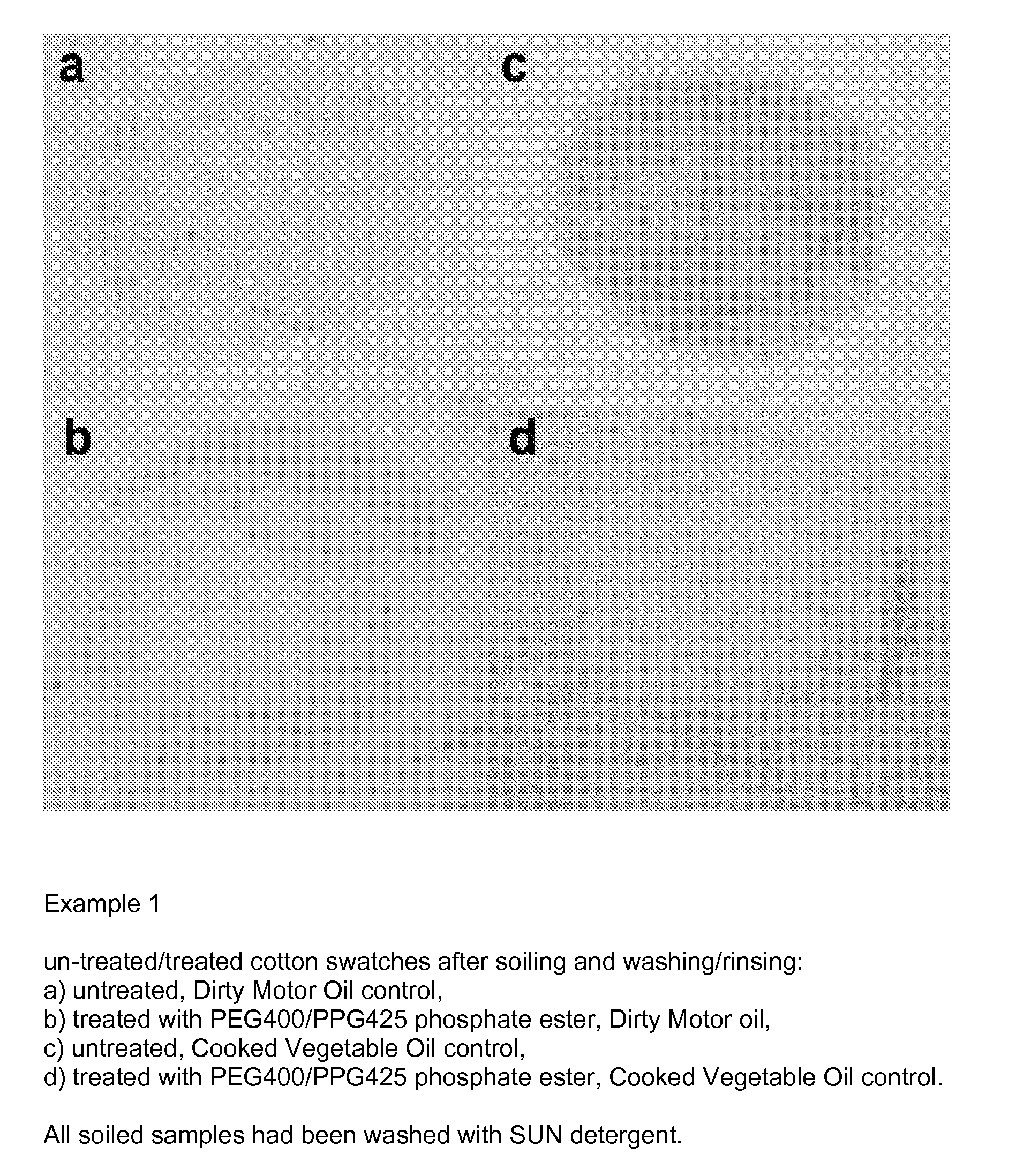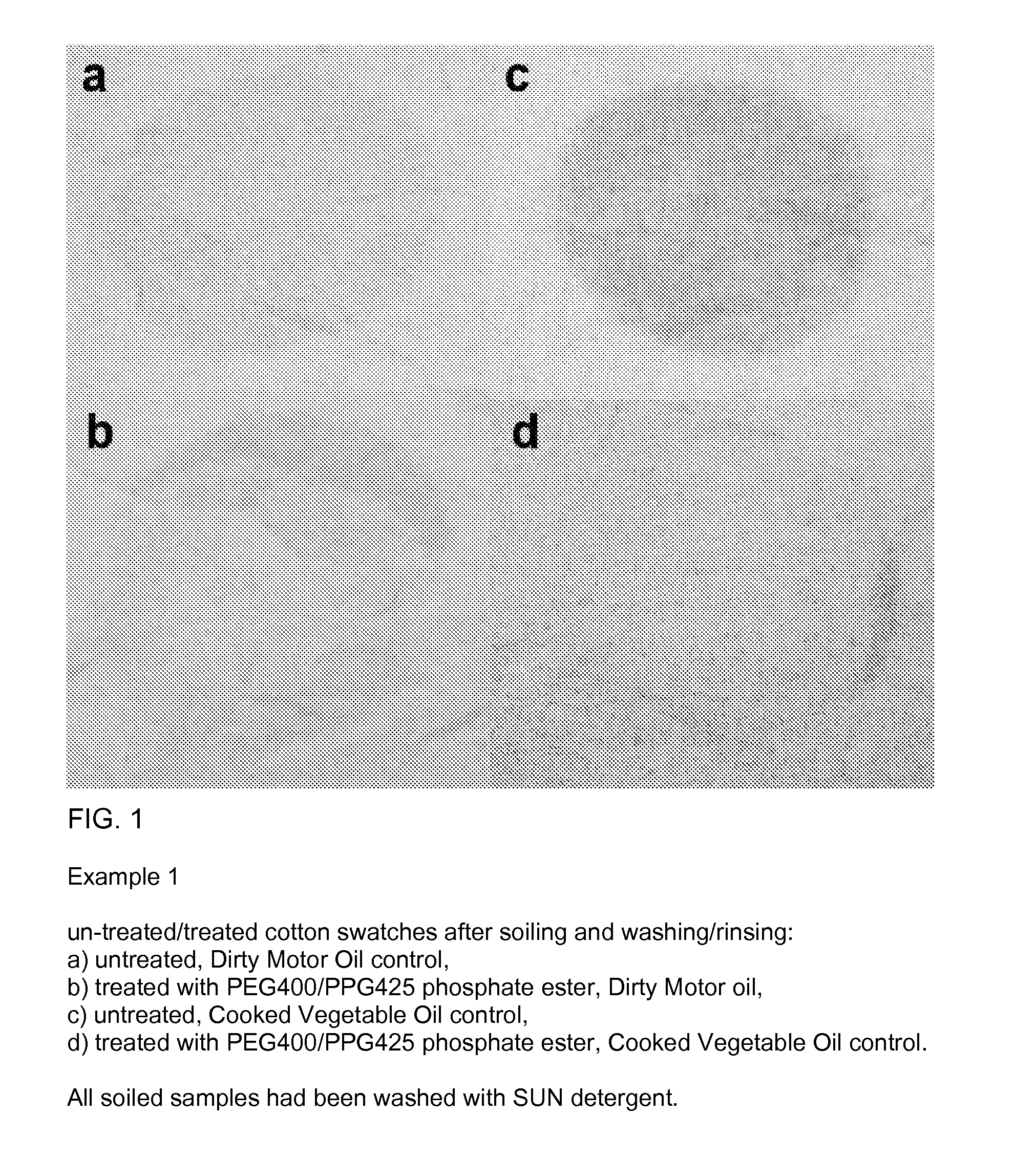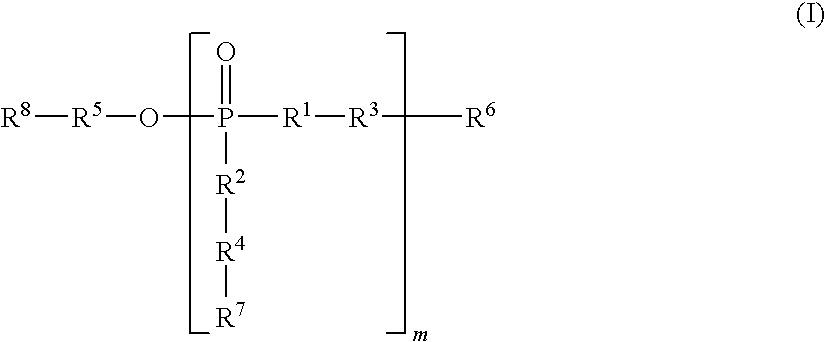Detergent composition with hydrophilizing soil-release agent and methods for using same
a technology of hydrophilic soil and detergent composition, which is applied in the direction of detergent compounding agent, liquid soap, group 5/15 element organic compound, etc., can solve the problems of difficult development of effective cotton soil release agent for use in laundry detergent, many cotton stains become “fixed", and cannot be easily removed in aqueous laundering process
- Summary
- Abstract
- Description
- Claims
- Application Information
AI Technical Summary
Benefits of technology
Problems solved by technology
Method used
Image
Examples
example 1
Pretreatment
Test Protocols
[0583]4 drops of 33 wt % solution in water with NaOH, pH 6-7, of each phosphate ester (PEG400 / PPG425 phosphate ester and PEG400 / Glycerine phosphate ester) in a square[0584]Allow 5 minutes “dry time”[0585]4 drops of soil added onto treated area of swatches (single knit cotton)
[0586](Note: Treated area is still wet!)[0587]5 g polymer free detergent in 1 L of water in tergetometer[0588]Swatches added to tergetometer vessels[0589]104° F. wash cycle for 20 mins, 90° F. rinse for 5 minutes in 1 L fresh tap water (3 times)
Results
[0590]FIG. 1 shows the results for the pretreatment with 33 wt % solution of PEG400 / PPG425 phosphate ester (soil added onto wet substrate) on cotton.
[0591]FIG. 1 shows photographs of un-treated / treated cotton swatches after soiling and washing / rinsing. In particular
[0592]Part (a) shows an untreated, Dirty Motor Oil stained control sample cotton swatch.
[0593]Part (b) shows a Dirty Motor oil stained cotton swatch treated with PEG400 / PPG425 p...
example 2
Pretreatment
[0597]Test Protocol
[0598]1. Treatment: Cotton or polyester or PPNW samples add to treating solutions, stir for a few minutes then take off and remove excess of solutions and dry into oven at 60° C. for 60 min.
[0599]2. Pre-Wash: Add samples to 1 L top water at 104° F., and then add 5 g of SUN detergent. Wash 20 min. (some tests had been done without this pre-washing step: no difference observed),
[0600]3. Colorimetric measurement of treated samples with Gardner TSC.
[0601]4. Stain: Stir the oil stains for 30 minutes prior to use. After treatment add 4 drops of stain oil onto treated area of swatch, dry into oven at 60 C for 1 hr.
[0602]5. Wash: Add samples to 1 L tap water at 104° F., and then add 5 g of detergent. Wash 20 min.
[0603]6. Rinse 3 times-5 min in 1 L fresh tap water at 104° F.
[0604]7. Dry: for 60 min in oven at 60° C.
[0605]8. Colorimetric measurement of samples with Gardner TSC
[0606]Treating Solutions:[0607]2% PEG400PE, pH=6.26[0608]2% REPEL-O-TEX SRP-6 (soil rel...
example 3
Durability Test
[0612]Test Protocol
[0613]5-times pre-washing after treatment / before staining:
[0614]1. Treatment: Cotton or polyester or PPNW samples add to treating solutions, stir for a few minutes then take off and remove excess of solutions and dry into oven at 60° C. for 60 min.
[0615]2. Pre-Wash: Add samples to 1 L top water at 104° F., and then add 5 g of SUN detergent. Wash 20 min. (some tests had been done without this pre-washing step: no difference observed).
[0616]3. Rinse 3 times-5 min for each cycle in 1 L fresh tap water at 104° F.
[0617]4. Dry: for 60 min in oven at 60° C.
[0618]5. Repeat steps 2-4 four times.
[0619]6. Colorimetric measurement of samples with Gardner TSC. Gardner TSC is an industry standard instrument that measures color of any surface
[0620]7. Stain: Stir the oil stains for 30 minutes prior to use. After treatment add 4 drops of stain oil onto treated area of swatch, dry into oven at 60° C. for 1 hr.
[0621]8. Wash: Add samples to 1 L tap water at 104° F., an...
PUM
| Property | Measurement | Unit |
|---|---|---|
| molecular weights | aaaaa | aaaaa |
| mean particle diameter | aaaaa | aaaaa |
| mean particle diameter | aaaaa | aaaaa |
Abstract
Description
Claims
Application Information
 Login to View More
Login to View More - R&D
- Intellectual Property
- Life Sciences
- Materials
- Tech Scout
- Unparalleled Data Quality
- Higher Quality Content
- 60% Fewer Hallucinations
Browse by: Latest US Patents, China's latest patents, Technical Efficacy Thesaurus, Application Domain, Technology Topic, Popular Technical Reports.
© 2025 PatSnap. All rights reserved.Legal|Privacy policy|Modern Slavery Act Transparency Statement|Sitemap|About US| Contact US: help@patsnap.com



